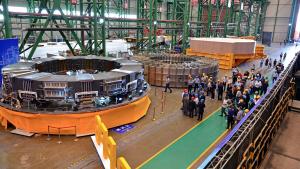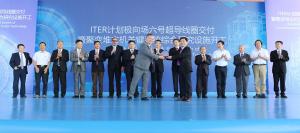A celebration for the first ring coil
A 400-tonne ITER magnet—poloidal field coil #6—has been completed in China through the collaboration of the European Domestic Agency (Fusion for Energy) and contractor ASIPP. The coil will reach ITER in December.
At the Institute of Plasma Physics, Chinese Academy of Sciences (ASIPP) in Hefei, a six-year-long industrial adventure has come to a close with the completion of the final fabrication steps on poloidal field coil #6 (PF6).
In 2013, the European Domestic Agency Fusion for Energy had been looking for an industrial partner to manufacture the smallest of the five poloidal field coils under its responsibility, and the only one that could be transported by sea and road to reach ITER. The collaboration agreement negotiated with ASIPP—which was signed in May that year—held advantages for both parties according to Jean-Marc Filhol, Head of the ITER Programme Department in the European Domestic Agency.
"Our partner ASIPP has been able to gain further experience in the manufacturing of large superconducting coils for tokamaks, while on our side, the collaboration has made it possible to deliver two coils on time to the ITER Organization—PF6 and PF5 (manufactured at the same time by European contractors in a dedicated facility at ITER)."
After its delivery to the ITER site, the PF6 coil will be cold tested by Fusion for Energy in the Poloidal Field Coils Winding Building. As the bottommost magnet, PF6 will be installed first during machine assembly, immediately followed in the installation sequence by PF5.
Working in close collaboration with project supervisors from Fusion for Energy, ASIPP's team of 80 was able to move steadily and methodically through each of the challenging fabrication phases:
- The winding of approximately 13 kilometres of niobium-titanium (NbTi) superconductor into nine double pancakes of rigorously controlled dimensions (profile accuracy of +/- 1.5 mm);
- The stacking and joining of the nine double pancakes, resin impregnation of the entire assembly, and finally the addition of piping, instrumentation and clamps delivered by the Chinese Domestic Agency.
- Testing, including dimensional, global leak, and high voltage tests.
When completely packaged for transport, the component will travel by barge on the Yangtze River to Shanghai, where it will be loaded for ocean transport to Fos-sur-Mer harbor in France, with the objective of arrival at ITER in the middle of December.
On 20 September, a ceremony was held in the ASIPP fabrication hall in the presence of representatives of the Chinese government at local and national level, the Chinese and European Domestic Agencies, ASIPP, and dignitaries. to celebrate the completion of the PF6 manufacturing and the launch of China's Comprehensive Research Facility for Fusion Technology (more on that planned facility here). After the speeches, video messages from the ITER Director-General, Bernard Bigot, and from the Director of Fusion for Energy, Johannes Schwemmer, were shown.
"Via this collaboration, ASIPP, the Chinese Domestic Agency, and Fusion for Energy have further strengthened the basis of the ITER Project, which relies heavily on efficient collaboration between the different ITER Members to realize unprecedented achievements," concludes Filhol.



